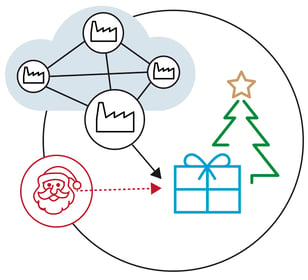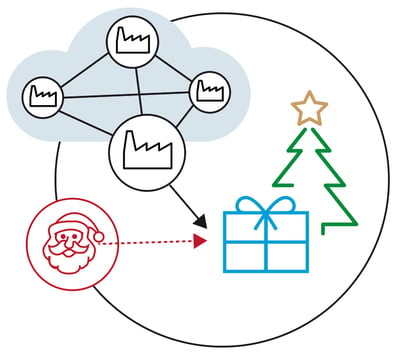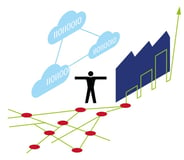How Industry 4.0 Will Impact Your Supplier Relationships
Brian Hoey - November 21, 2019

 Depending on your background, when you were a child your parents might have told you that your Christmas presents came from Santa Claus. From a supply chain planning perspective, this would have made things difficult for you, since your only source of information was fairly opaque, and you had little insight into the distribution mechanisms for toys and gifts. As a result, you were stuck jumping through whatever holiday hoops were presented to you, whether that was mailing a letter to St. Nick or putting out milk and cookies the night before. Once you realized the truth, however, all bets were off. At that point, you knew that the things that wound up under the tree just came from the toy store, and if you were feeling enterprising you could change your supplier relations to arrive at more favorable terms.
Depending on your background, when you were a child your parents might have told you that your Christmas presents came from Santa Claus. From a supply chain planning perspective, this would have made things difficult for you, since your only source of information was fairly opaque, and you had little insight into the distribution mechanisms for toys and gifts. As a result, you were stuck jumping through whatever holiday hoops were presented to you, whether that was mailing a letter to St. Nick or putting out milk and cookies the night before. Once you realized the truth, however, all bets were off. At that point, you knew that the things that wound up under the tree just came from the toy store, and if you were feeling enterprising you could change your supplier relations to arrive at more favorable terms.
This example might seem a bit fanciful, but it reflects a real truth about the way that Industry 4.0 is changing the interactions between different touchpoints on the supply chain. Where, in the past, a manufacturer might have struggled to get the data they wanted from their suppliers in a transparent way, new technology like the internet of things (IoT) is changing the calculus when it comes to information sharing. Things that were once considered luxuries are now becoming baselines for collaboration, and businesses are going to have to adapt to these changing realities.
The Data Revolution
Okay, but what exactly are the changes that are pushing this shift in manufacturer-supplier relationships? At heart, they’re all related to data. As things like IoT devices, RFID chips, smart pallets, and smart containers enter the supply chain at various touchpoints, the organizations that utilize them are gathering increasing amounts of information about the conditions of parts in transit, machine functionality, and demand/order information. Once this data is gathered, it’s up to businesses to actual make use of it—whether that’s through advanced analytics, real-time reporting, or any other digitally-driven enhancement to the planning and scheduling processes.
Of course, making use of the data you collect is often easier said than done. Businesses need IT environments that reduce silos and increase visibility in order to give things like predictive analytics algorithms the chance to add value, and creating this kind of IT environment often requires a sustained investment in digitization. With that investment, however, comes the ability to power a digital platform for interactions between buyers and suppliers. After all, if you can make information readily available within your own IT environment, why couldn’t you extend (some of) that visibility to your supply chain partners? Sure, not everyone is on board with making the switch to a digital platform for collaboration, but Industry 4.0 is making it more feasible than ever, driving a new set of expectations for these sorts of supply chain interactions.
Flattening Out the Supply Chain
For a mid-sized manufacturer, this shift towards digitization has the potential to increase visibility into your existing suppliers and give you the flexibility to expand beyond them as needed. Where, in the past, relatively opaque supply chain operations meant that a disruption in your supplier’s value chain could have a cascade effect throughout all of the other touchpoints (leading to lost value in the form of late order fulfillment), in a more digitized environment there’s a decreased risk that you’ll be blindsided by a last minute parts outage. Why? Because you’ll have access to information that will enable you (or your advanced analytics) to see the shortage coming well in advance. Thus, you can incorporate other arrangements into your plans—whether that’s bundling your order differently with one of your other suppliers, getting creative with your buffer stock, or adjusting your transport plans to account for slightly different production schedules.
Ultimately, the effect here is that the supply chain potentially becomes much less hierarchical. A disruption upstream doesn’t automatically translate into an equivalent disruption downstream, because different touchpoints all interconnect in a more visible manner. Much like we’re seeing with the rise of smart, digital route and tour planning in logistics, manufacturers and their partners are in a position to break out of the mindset whereby each part and product has to the take the same linear path from raw material to finished product over and over again. Maybe, depending on what’s happening elsewhere on the value stream, some parts of your new electric car can be produced at a secondary plant that’s closer to a cache of available resources, then transported to be recombined with the rest of the automobile via logistics backhauls.
Raising the Supply Chain Technology Bar
So far, we’ve talked about changing supplier relationships in Industry 4.0 mostly with an eye towards ways that manufacturers will be able to mitigate disruptions that might otherwise result from upstream occurrences. In point of fact, however, Industry 4.0 technologies will often put manufacturers and their suppliers in a position to add mutual value for one another. If, for instance, you’re able to integrate your IT system with that of a crucial supply chain partner, that could lead to new avenues for cooperation and collaboration. Maybe you’ll realize that you could utilize backhauls more regularly to drive down both of your respective shipping costs, or that you could share hubs or cross-docks based on complementary seasonalities in your businesses.
The trick here is that in order to gain this kind of value from your suppliers, your own IT environment has to be up to snuff, i.e. you need to be able to affect meaningful IT integration up and downstream in the supply chain. This doesn’t mean that you have to achieve Industry 4.0 adoption overnight, but it does mean that you may have to take some steps to improve visibility across your operations. This might begin with breaking down data and decision-making silos and rooting out shadow IT. From there, you might audit your existing data to see how it’s collected, stored, and analyzed—then create a roadmap for how to implement advanced analytics workflows. At the point where you’ve got that level of visibility, you’re probably in a position to offer (some) of that visibility to your suppliers in order to uncover new areas of alignment and potential sources of synergy.
LATEST POSTS
- Understand Circular Economy in The Manufacturing Industry
- How Can Industry 4.0 IT Integration Be Achieved Smoothly?
- The Significance of Order Sequencing in Discrete Manufacturing
- How to improve your Supply Chain Management: The Power of Control Towers
- Optimizing Human Resource Scheduling in Manufacturing: A Technological Approach



